Introduction
Thrixspermum Lour. (Loureiro 1790: 519) is a large orchid genus of ca. 168 accepted taxa in subfamily Epidendroideae, tribe Vandeae, subtribe Aeridinae (sensuChase et al. 2015, Pridgeon et al. 1999, 2014). It is distributed from subtropical and tropical Asia to Australia and the western Pacific (Govaerts et al. 2021, O’Byrne 2016, Wood 2014). The genus is of limited ornamental value due to its ephemeral and often small flowers, but it has been used as an ingredient in traditional medicine and in the flavouring and perfume industries (Burkill 1935, Chuakul 2002, Kaiser 1993). Because of its ephemeral flowers, which are infrequently produced and do not preserve well when dried (Williams 1938), it is poorly represented in herbaria, and dried material can be hard to interpret. As a result, Thrixspermum is taxonomically difficult, and a modern taxonomic revision based on morphometrics and molecular studies is much needed (O’Byrne 2016, O’Byrne et al. 2015, Seidenfaden 1988).
Although Thrixspermum is mainly epiphytic, some species can also occur as lithophytes, and a few are scrambling terrestrials in open terrain. They most frequently occur in tropical rain forest, peat swamp forest, and dry evergreen forest, but also in lower montane rain forest, lower montane coniferous forest, and lower montane scrub. The genus is characterized by the laterally flattened or swollen inflorescence rachis, ephemeral flowers, an immobile, 3-lobed, basally saccate lip, usually with a central callus, a distinct column-foot, and four unequal pollinia with stipe and viscidium (Pridgeon et al. 2014). As a result of molecular studies, the genus Cordiglottis J.J.Sm. was included in Thrixspermum (Chase et al. 2015, Kocyan & Schuiteman 2014, Wood 2014). Three sections have been distinguished previously: sects. Thrixspermum (syn. sect. Orcidice Rchb.f.), Dendrocolla (Blume) J.J.Sm., and Katocolla Schltr. (Schlechter 1911, Seidenfaden 1988, Smith 1905). The last-mentioned is no longer recognised (O’Byrne 2015, Seidenfaden 1988, Wood 2014) and is now included in sect. Dendrocolla.
Even though the orchid flora of Thailand has so far not been completely revised, ca. 1100 species are estimated to occur (Schuiteman & de Vogel 2000). Fifteen species of Thrixspermum have been recorded from Thailand (Seidenfaden 1988) and forty from Peninsular Malaysia (Ong et al. 2017). During preparations for a taxonomic revision of the genus Thrixspermum in mainland Southeast Asia by the first author, an undescribed species was discovered in Narathiwat province, southern Thailand, and it turned out that the second author had found the same species in Kelantan, Peninsular Malaysia. Therefore, it is described here as a new species.
Materials and methods
Plant collections and documentation were made following standard practice (Bridson & Forman 1992). Living plants were collected under license from Narathiwat province, southern Thailand, and cultivated at an evaporative cooling greenhouse in Queen Sirikit Botanical Garden, Chiang Mai, northern Thailand. The Peninsular Malaysian plant was collected with permission from the Peninsular Malaysian Forest Department and Kelantan Forest Department and cultivated at the Forest Research Institute Malaysia at Kepong. Voucher specimens were collected and photographed from this living collection and made by fixing in 70% ethanol (Bridson & Forman 1992) and deposited at the Thai Traditional Medicine Herbarium (TTM), Bangkok Forest Herbarium (BKF), Queen Sirikit Botanical Garden (QBG) and the Kepong Herbarium (KEP, only for the Peninsular Malaysian material). Colour photographs with scale were created using Nikon D7100 with Nikon 18-105 mm VR DX, Tamron SP AF 70-300 F/4-5.6 Di VC USD, and AF-S Micro NIKKOR 60 mm f/2.8G ED lenses, including habitat, plant habit, stem, roots, leaves, inflorescences, flowers, and floral dissected parts (Baskauf & Kirchoff 2008). Plant identification, description, and line drawing were performed under a stereo microscope (Leica EZ4W) and following the terminology of Kew Plant Glossary (Beentje 2016). Relevant orchid publications, available protologues, and (images of) type specimens of Thrixspermum species from tropical Asia were reviewed to confirm the identification and to make morphological comparisons with allied species. The photographic composition of the floral dissected illustration was edited with Adobe Photoshop® CS6. A distribution map was generated employing RStudio (2015). Conservation status was estimated following the IUCN Red List categories and criteria version 3.1, second edition (IUCN 2012).
Taxonomic treatment
Thrixspermum obyrneanum N.Toolmal, P.T.Ong & Schuit., sp. nov.Fig. 1-5.
TYPE: Thailand. Peninsular Thailand: Narathiwat, 27 October 2020, N.Toolmal, A.Baka, A.Seepae & W.Tanming 27102001 (holotype TTM; isotypes: BKF, QBG).
Diagnosis: Thrixspermum obyrneanum differs from T. leucarachne Ridl. in the much shorter sepals and petals (2.1-4.2 vs. 6.5-8.0 cm long), tepals and lip pale yellow (vs. tepals pale yellow or white, tinged with purple at the base, lip white), lateral lobes of the lip 6-7 mm long, broadly triangular to ovate, with narrowly truncate and erose apex (vs. 7-8 mm long, narrowly triangular to oblong, with obtuse, unequally bilobed apex), mid-lobe 3.0-4.7 mm long, cylindrical to broadly triangular, obtuse (vs. 6-9 mm long, narrowly triangular, acute).
Epiphytic herb. Stems patent, 6 cm to at least 30 cm long, with 6-27 internodes, cylindrical, slightly laterally compressed, curved upwards from the middle, covered with the leaf sheaths, 6-12-leaved; internodes 3-12 × 0.5-5.5 mm. Roots cylindrical, thick, elongate, 13 cm to at least 50 cm long, 0.6-2.0 mm diam., arising from the basal part of the stem and from nodes at the lowest leaf, not or sparsely branching. Leaves green, sometimes spotted or suffused with purplish red turning to brown and sulcate with age, patent, narrowly oblong to elliptic, 5-18 × 1.3-2.0 cm, sessile, slightly narrowed to the base, leaves on the same side of the stem 1.5-3.0 cm apart, dorsiventrally flattened, thick, rigid, fleshy, coriaceous, apex slightly unequally bilobed with obtuse lobules, with a small mucro in the middle, the midrib distinct; leaf sheaths green, sometimes spotted or suffused with purplish red turning to brown with age, slightly bilaterally compressed, longer than the stem internodes. Inflorescences one to several per plant, patent, racemose, 4.9-18.0 cm long, long pedunculate, arising from the nodes at the opposite side of the leaves and below the roots, green with purplish red spots; peduncle slender, slightly upwards curved from the middle, 80-220 × 1-5 mm, with 3 internodes, the basal internode fairly short, stout, 6-8 mm long, 2.3-2.4 mm in diam., the middle internode normally longer and thinner, 4.5-7.0 cm long, 1.5-2.3 mm in diam., the terminal internode strongly compressed distally, 2-4 cm long, broadening to 2.2-5.0 mm diam. just below rachis; peduncle scales 2-3, green-yellowish green, ovate to broadly triangular, incurved, concave, thickened, slightly boat-shaped, clasping the peduncle, 5-7 × 1.7-2.0 mm, apex acuminate, keeled; rachis 2.7-7.5 cm long, depending on the age of the inflorescence, 17-30-flowered, with one or two flowers open at a time, strongly bilaterally flattened, with distichous, persistent floral bracts, 0.8-1.5 mm apart, 6.3-8.7 mm wide across the floral bracts. Floral bracts yellowish green with purplish red spots, bilaterally flattened, ovate to broadly triangular, incurved, concave, thickened, slightly boat-shaped, clasping the rachis, 3.8-7.0 × 2-3 mm, apex acute-acuminate, keeled. Flowers non resupinate, opening widely; tepals pale yellow, lip pale yellow, tinged with purplish red on both surfaces of the sac and between the lateral lobes, callus creamy white, lasting only one day, membranaceous, 4-8 cm across, mildly sweet-scented. Dorsal sepal linear, 31.5-42.0 × 2.8-3.0 mm, slightly tapering towards the apex, slightly concave, somewhat twisted near the base, apex acuminate, 5-nerved, glabrous. Lateral sepals linear, obliquely subhorizontal, 33.5-42.0 × 3.2-3.5 mm, slightly tapering towards the apex, rather concave, somewhat twisted and expanded near base, apex acuminate, 5-nerved, glabrous. Petals similar to sepals, slightly smaller, obliquely, 21.5-38.0 × 1.9-2.5 mm, apex acuminate, 5-nerved, glabrous. Lip oblong to broadly ovate in outline, 3-lobed, 11.6-13.0 × 3.0-3.5 mm in natural position, strongly saccate at the base; sac narrowly conical, 3-4 × 3.0-3.2 mm, slightly bilobulate with obtuse lobules, on the back wall densely covered with 1.0-1.3 mm long glandular hairs; lateral lobes narrowly triangular to ovate, slightly falcate, 6-7 × 2-4 mm, free part 1.2-1.8 mm long, erect, slightly incurving around column, apical margins with shortly pubescent, adaxial surface glabrous, abaxial surface sometimes with pubescent and sparsely long glandular hairs, apex narrowly truncate and erose; mid-lobe cylindrical to broadly triangular, ca. 3.0-4.7 × 3 mm, ca. 4.7 × 5.0 mm (spread out), concave from base to apex, producing a navicular shape, densely covered with long glandular hairs adaxially (1.0-1.3 mm long), pubescent abaxially, thick (0.8-1.0 mm), more or less evenly thick from base to apex, apex obtuse (slightly unequally bilobed in lateral view), weakly decurved; lip between the lateral lobes sparsely covered with long glandular hairs adaxially, pubescent abaxially, with a tongue-shaped callus a little below the midlobe, callus 1.8-2.0 mm long, 1.5-1.8 mm diam., glabrous, apex obtuse, decurved. Column creamy white to pale yellow, cylindrical, short, stout, 1.8-2.0 × 1.8-2.0 mm, laterally winged; column-foot creamy white, short, broad, 2-3 × 1.9-2.5 mm. Anther creamy white to pale yellow, suborbicular in outline, glabrous, 1.0-1.2 × 1.2-1.5 mm, the median with a longitudinal ridge. Pollinia bright yellow, in 2 highly unequal pairs, lanceolate-ellipsoid, curved; the larger ca. 1.0 × 0.5 mm; the smaller, ca. 0.8 × 0.3 mm; stipe creamy white, broadly ovate-elliptic, ca. 0.5 × 0.5 mm, concave in the median, slightly translucent; viscidium cream-white, transverselinear, ca. 0.2 × 0.6 mm, recurved into a crescent shape, slightly translucent. Pedicel-with-ovary pale yellow to pale green, cylindrical, 6-grooved, 7-12 × 1.0-1.2 mm. Fruit green with dark brown spots, narrowly cylindrical, ca. 6 × 1-2 cm, with 6 longitudinal ridges. Described from living plants and flowers, and spirit material.
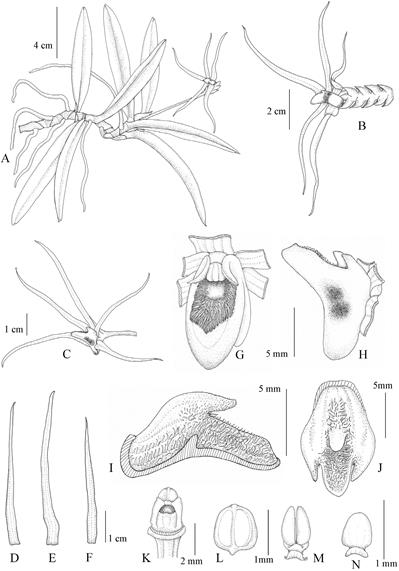
A. Habit.
B. Rachis with flower.
C. Flower (lateral view).
D. Dorsal sepal.
E. Lateral sepal.
F. Petal.
G. Lip (front view).
H. Lip (lateral view).
I. Lip (longitudinal section).
J. Lip (adaxial view, spread out).
K. Column (ventral view).
L. Anther.
M. Pollinia, with stipe, and viscidium.
N. Stipe and viscidium.
Drawn from holotype by Phataravee Prommanut.
Figure 1 Thrixspermum obyrneanum from southern Thailand.
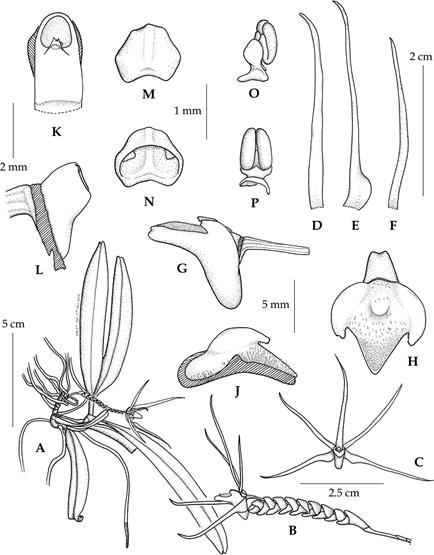
A. Habit.
B. Inflorescence with flower (lateral view).
C. Flower (front view).
D. Dorsal sepal.
E. Lateral sepal.
F. Petal.
G. Lip with column and pedicel-with-ovary (lateral view).
H. Lip (adaxial view, spread out).
J. Lip (longitudinal section).
K. Column and column-foot (ventral view).
L. Column and column-foot (lateral view).
M-N. Anther.
O-P. Pollinia, with stipe and viscidium.
Drawn by Ong Poh Teck based on Ong FRI 88546 (KEP).
Figure 2 Thrixspermum obyrneanum from Peninsular Malaysia.
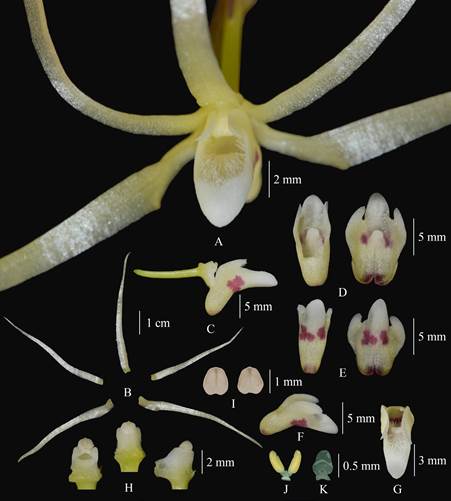
A. Flower (closed up, front view).
B. Dissected perianth.
C. Pedicel-with-ovary, column, and column-foot with lip (lateral view).
D. Lip, adaxial (left: natural position; right: spread out).
E. Lip, abaxial (left: natural position; right: spread out).
F. Lip (oblique view).
G. Mid-lobe (adaxial view).
H. Column and column-foot (ventral, dorsal & lateral views).
I. Anther.
J. Pollinia, with stipe and viscidium.
K. Stipe and viscidium.
Photographed by Wattana Tanming (A-H), Nopparut Toolmal (I) and Phataravee Prommanut (J-K). Illustration assembled by Yongyuth Rattanasootr. A-I from living collection and J-K from spirit collection of N. Toolmal et al. 27102001 TTM 0006369.
Figure 3 Thrixspermum obyrneanum.
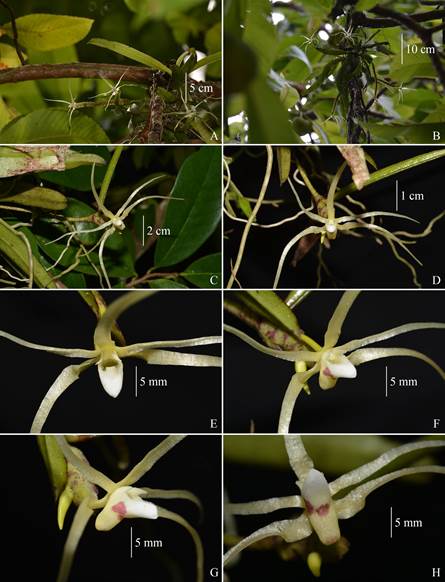
A-B. Plant habit.
C-D. Flower and fruit (front view).
E. Flower (close up, adaxial view).
F-G. Flower (close up, oblique view).
H. Flower (closed up, abaxial view).
Photographed by Nopparut Toolmal (A-H) in situ. Illustration assembled by Yongyuth Rattanasootr.
Figure 4 Thrixspermum obyrneanum, southern Thailand.
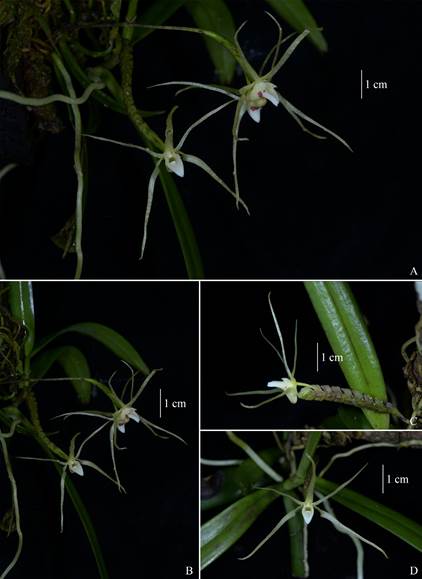
A-B. Plant habit with flowers (front and oblique views).
C. Flower (lateral view).
D. Flower (front view).
Photographed by Ong Poh Teck from living collection of Ong FRI 88546. Illustration assembled by Yongyuth Rattanasootr.
Figure 5 Thrixspermum obyrneanum, Peninsular Malaysia.
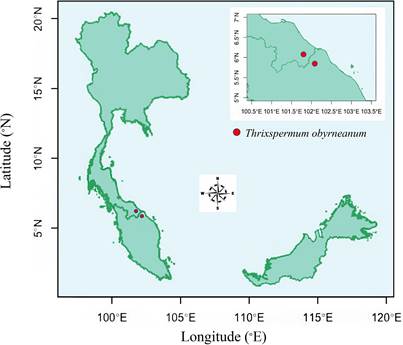
Illustration by Nopparut Toolmal.
Figure 6 Distribution map of Thrixspermum obyrneanum from Southern Thailand and Peninsular Malaysia.
Etymology
This species is named in honour of the late Peter O’Byrne (1955-2018), who has done much valuable work on Thrixspermum and many other groups of orchids in Southeast Asia.
Phenology
Flowering recorded in January, May and November in cultivation and in October in the natural habitat. Flowering is probably intermittent throughout the year.
Habitat and ecology
In Thailand, epiphytic in orchards along the roadside and in tropical evergreen forest, at 10-120 m in elevation., commonly found on twigs of trees, including Garcinia mangostana L. (Clusiaceae), Dillenia indica L. (Dilleniaceae), Baccaurea lanceolata (Miq.) Müll.Arg. (Phyllantaceae), and Ficus sp. (Moraceae) at about 2-10 m above the ground and frequently near waterfalls or along streams in somewhat exposed positions. In Peninsular Malaysia, epiphytic on tree branches at the base of a limestone hill.
Conservation status
This taxon is common in tropical rain forest of Narathiwat province, which covers an area of more than 183 km2. At present, it is only known in Thailand from this locality, but it may be expected to occur in neighbouring hills. For the time being, T. obyrneanum is assessed as a ''Data Deficient'' (DD) in Thailand, according to the IUCN criteria (IUCN 2012), as more information on its distribution and population status is needed for an accurate evaluation. Similarly, a global assessment would require more data about the occurrence in Peninsular Malaysia.
Vernacular (Thailand)
Meng Moom Khao O’Byrne (แมงมุมขาวโอเบริน), Meng Moom Khao Nara (แมงมุมขาวนรา), Meng Moom Khao Hala-Bala (แมงมุมขาวฮาลาบาลา).
Specimens examined
Peninsular Thailand: Narathiwat, Su-Ngai Kolok, 23 October 2020, N. Toolmal & W. Tanming 23102003 (TTM 0006368!). Peninsular Malaysia: Kelantan, 19 November 2017, Ong FRI 88546 (KEP, spirit barcode SC9302).
Taxonomic notes
Among the other species of Thrixspermum in Thailand, T. obyrneanum is morphologically most similar to T. leucarachne Ridl. (1896: 397), which is widespread from north-eastern and eastern Thailand down to the middle of southern Thailand. Thrixspermum obyrneanum is distinguished by the much smaller flower, with sepals and petals 2.1-4.2 cm long (vs. 6.5-8.0 cm). While their flower colours, which are variable in T. leucarachne, can be similar, the flowers are never white and tinged with purple at the base of the sepals and petals in Thrixspermum obyrneanum. The lip colour is also different. Whereas it is white, tinged with purplish-red on both surfaces, except the mid-lobe, in T. leucarachne, it is pale yellow, tinged with purplish-red only on both surfaces of the sac and between the lateral lobes in T. obyrneanum. Thrixspermum obyrneanum can also be distinguished by the shape and length of the lateral lobes, which are broadly triangular to ovate, slightly falcate, 6-7 mm long, apex narrowly truncate and erose (vs. narrowly triangular to oblong, falcate, 7-8 mm long, with obtuse and unequally bilobed apex). The two taxa also differ in the morphology of the lip-mid-lobe. Whereas this is almost cylindrical to broadly triangular, ca. 3.0-4.7 × 3 mm, and obtuse in T. obyrneanum, it is narrowly triangular, 6-9 × 4-5 mm, and acute in T. leucarachne (Fig. 3, 4, 5, 7, Table 1).
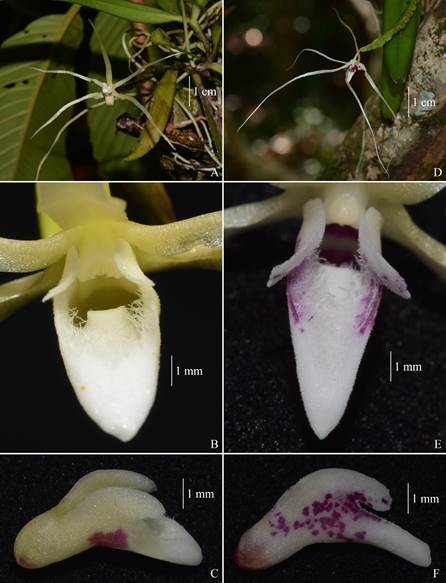
A. Flower (front view).
B. Mid-lobe (close up, adaxial view).
C. Lip (oblique view).
D. Flower (front view).
E. Mid-lobe (close up, adaxial view).
F. Lip (lateral view).
Photographed by Nopparut Toolmal (A, B, D) & Wattana Tanming (C, E, F). Illustration assembled by Yongyuth Rattanasootr.
Figure 7 Morphological comparison between Thrixspermum obyrneanum (A-C) and T. leucarachne (D-F).
Table 1 Differences between Thrixspermum leucarachne and T. obyrneanum in Thailand.
| Characters | T. leucarachne | T. obyrneanum |
|---|---|---|
| Flower (size) | 8-12 cm across | 4-8 cm across. |
| Tepals colour | White, rarely pale yellow, tinged with purple at the base. | Pale yellow. |
| Dorsal sepal length | 6.5-8.0 cm | 3.1-4.2 cm |
| Lateral sepals’ length | 6.5-8.0 cm | 3.3-4.2 cm |
| Petals length | 6-7 cm | 2.1-3.8 cm |
| Lip colour | White, tinged with purplish red throughout both surfaces of the lip, except the mid-lobe. | Pale yellow, tinged with purplish red only on both surfaces of the sac and between the lateral lobes. |
| Lateral lobes shape | Narrowly triangular to oblong, falcate. | Broadly triangular to ovate, slightly falcate. |
| Lateral lobes length | 7-8 mm | 6-7 mm |
| Lateral lobes apex | Obtuse, unequally bilobed. | Narrowly truncate and erose. |
| Mid-lobe shape | Narrowly triangular. | Cylindrical to broadly triangular, depressed. |
| Mid-lobe (size) | 6-9 × 4-5 mm | ca. 3.0-4.7 × 3 mm |
| Mid-lobe apex | Acute, slightly decurved. | Obtuse, decurved. |
Comparing the Peninsular Malaysian Thrixspermum using Seidenfaden & Wood (1992), T. obyrneanum keys out close to T. iodochilus Ridl. and T. centipeda Lour. Both have a glabrous mid-lobe, whereas in T. obyrneanum this is in part covered with long glandular hairs. In T. iodochilus, the mid-lobe is violet, narrowly tongue-shaped, and the apex of the lateral lobes is truncate with entire margin (Seidenfaden & Wood 1992, Fig. 291a). In T. centipeda, the mid-lobe is white, and the apex of the lateral lobes is broadly rounded with a slightly erose margin. In contrast, in T. obyrneanum the lip is pale yellow, and the apex of the lateral lobes is narrowly truncate with a slightly erose margin. There are also no close similarities between T. obyrneanum and some of the newly described Thrixspermum species from Peninsular Malaysia by O’Byrne et al. (2015).
Among Bornean Thrixspermum species, T. obyrneanum is close to T. kipandicum P.O’Byrne & Gokusing and T. lanatum P.O’Byrne & Gokusing.
Both differ from T. obyrneanum in tepal length, lip shape, and hairiness of the lip. In T. kipandicum, the sepals and petals are two to three times longer; the mid-lobe is cylindrical, slightly depressed at the base (ca. 3 mm long), convex at the distal half (ca. 4 mm long), and glabrous on both surfaces. Thrixspermum obyrneanum is easily distinguished from T. lanatum by the long glandular hairs adaxially at the base of the mid-lobe.
Surprisingly, given their geographical separation, T. obyrneanum is similar to T. validum J.J.Sm. from New Guinea regarding floral morphology. However, Thrixspermum validum differs from T. obyrneanum in the more robust plant habit with much longer and stouter stems, internodes 17.5-20.0 mm long (vs. internodes 3-12 mm long), and much broader leaves, 3.3-3.6 cm wide (vs. 1.3-2.0 cm wide). The inflorescence is also longer, ca. 20 cm long in total (vs. 4.9-18.0 cm). The lip of T. validum is clearly longer than in T. obyrneanum, 1.7 cm long (vs. 1.1-1.3 cm) and minutely papillose (vs. densely covered in long glandular hairs, especially on the adaxial side of the mid-lobe and on the floor of the sac). The callus on the lip of T. validum is papillose, whereas, in T. obyrneanum, the callus is largely glabrous except for the sparsely long glandular hairs at the base (Smith 1905, 1908, 1909, 1916).












 uBio
uBio 

